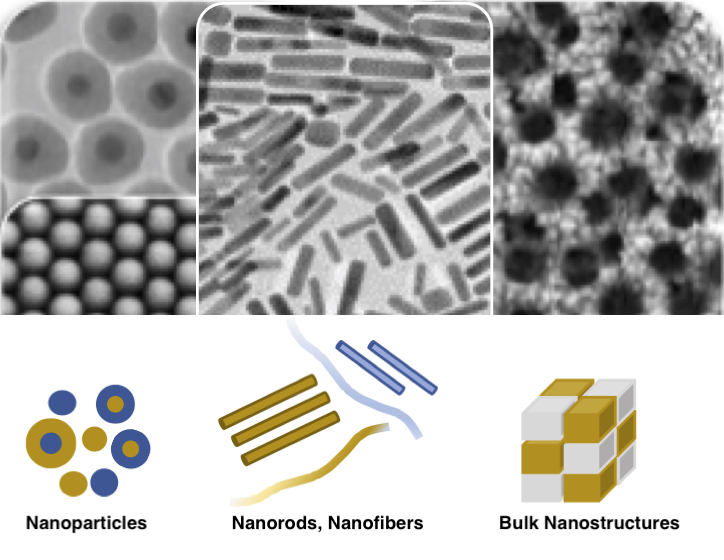Nanochemistry
Our research
The focus of the research group is on designing and developing novel nanomaterials architectures with desired characteristics; developing energy and resource effective synthesis methods as well as detailed microstructural, physicochemical, thermo-physical and transport characterisations. Nanomaterials can simply be defined as materials having size of less than 100 nm in one of their physical dimensions, while a change in their physical/chemical properties are observed accompanying the size reduction. Currently our work is focusing on design, fabrication and characterisation of nanomaterials for energy and medicine. These areas have different requirements with respect to the final materials' characteristics that can not be tackled with streamline conventional synthesis/fabrication process, where more chemistry knowledge, skills and imagination comes into the picture. That is when it gets very interesting!

Engineering nano materials, and interfaces, is a probably the best term to describe what we do. Materials requirements are getting increasingly complex for a variety of applications. Not only their fabrication but also their processing, stabilisation to be linked to surfaces or dispersed in proper base liquid requires a wide set of skills for their fabrication with desired composition and morphology, where the dispersion, or adhesion, characteristics are more defined by their surfaces. Surface modification schemes is an essential part of the progress in materials science. Of course detailed materials characterisation is a strong skill-set we posses in our research to be able to define the materials designed and fabricated for a special purpose.
Some snippets from ongoing research are given below:
Thermoelectric (TE) materials can play a very important role in efficient energy harvesting, and recovery. TE devices are ‘fuel-free’ solid-state devices with no moving parts and therefore are extremely reliable. TEs can harvest residual low-grade energy which otherwise is wasted. My group has coordinated a big EU funded project on nanoengineered thermoelectric materials (NEXTEC), focusing on power generating in the intermediate temperature range. More environment friendly composition of TE materials based on Mn and Mg silicides are also investigated through financing from Energimyndigheten. Scalable thermoelectrics is another direction we are aiming at developing for low grade heat harvesting applications via financing from SSF, under my coordination, which is one of five strategic area projects selected in 2012. Currently we are one of the key partners on materials synthesis and processing in a FET-Open Project focusing on hybrid thermoelectrics. A recent interview on TE materials can be found online.
In the field of energy efficiency we focused on the design and fabrication of nanofluids for enhanced heat transfer (NANOHEX). VR recently financed a continuation of this VR-NANOHEX project for another three years, where we already have some important findings and applied for IPR protection to secure the know-how (Nanohex Brochure). Currently we are working on energy storage materials (PCMs) and boiling in nano-enhanced micro tubes together with our colleagues from the Energy Department of KTH. A recent interview about nano fluids is published at KTH very recently, which can be reached
Biomedically applicable nanoparticles are among the materials we have developed and tested for a variety of functions, mainly for imaging contrast agent and possibly for targeted drug delivery. Many platform materials based on super paramagnetic iron oxide nanoparticles and their surface modifications with silica, as an inert coating material to develop core-shell nanostructures, have been fabricated using combinatorial chemistry methods and tested for their toxicity on various primary cell lines. Heavy-metal free nano phosphors based on rare-earth oxides are currently under development that have the dual function of up- and down-conversion characteristics that will allow visualisation of targeted tissues by the help of fluorescence microscopy. Currently, in a KAW funded collaborative project we are focusing on x-ray fluorescent nanoparticles for improved resolution of x-ray imaging.
Research projects:
• Solid-liquid thermoelectric systems with uncorrelated properties (EC – H2020; 2020-2024)
• Tuning elektronisk transport av material genom att verka utanför kristallgittret (VR; 2019-2021)
• Large-scale Microwave Assisted Heating Reactor for High Throughput ( Scale-up ) Synthesis of Nanomaterials (Stiftelsen Olle Engkvist Byggmästaren; 2018-2019)
• Låg Dimensionella Termoelektriska Material för Utvinning av Energi från Spillvärme (Energimyndigheten; 2017-2020)
• Molecular X-ray imaging (Knut and Alice Wallenbergs Foundation; 2017-2021)
• Metal Assisted Chemical Etchng (MACE) of Silicon Zone Plate Structures (PI: Prof Ulrich Vogt; 2016- )
• Enhanced Nanofluid Heat Exchange (VR; 2014-2016):
• A new generation of wireless sensors for integrated precise agriculture (EC-FP7; 2014-2016): AGRISENSACT
• Scalable Thermoelectrics (SSF; 2012-2016): SCALABLETEG
• Next Generation Thermoelectric Converters - NEXTEC (EC-FP7; 2012-2014)
